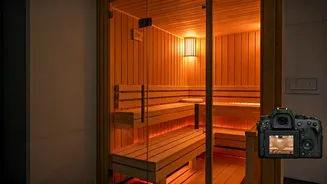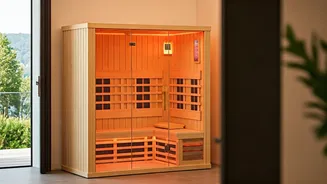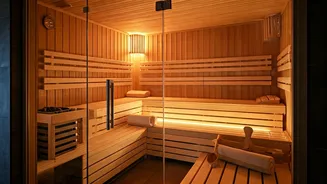Sauna's Growing Popularity
The appeal of at-home saunas has significantly increased recently, reflecting a broader trend towards self-care and wellness within the comfort of personal
spaces. Modern life's stressors and the desire for convenient relaxation have driven this surge. Home saunas provide an accessible escape for both relaxation and potential health benefits. The convenience of having a sauna readily available, eliminates the need for travel to spas or fitness centers, appealing to busy schedules and individual preferences for privacy and hygiene. This trend also underscores a shift in how individuals prioritize their well-being, integrating spa-like experiences into their daily lives.
Different Sauna Types
There are several types of at-home saunas, each utilizing distinct heating methods and offering unique experiences. Traditional saunas use heated rocks over a stove, creating high temperatures and humidity levels. Infrared saunas use infrared lamps to heat the body directly, often at lower temperatures than traditional saunas, which is deemed more accessible for individuals sensitive to high heat. Furthermore, there are also combination saunas that blend both infrared and traditional heating techniques, providing a versatile option. Finally, steam rooms, though technically not saunas, are also a popular choice for home wellness, which involves high humidity and is known to promote relaxation. Each type caters to different preferences and health needs, so it is crucial to research which suits individual requirements.
Choosing the Right Sauna
Selecting the appropriate at-home sauna is a crucial step that involves several considerations to align the choice with personal needs and space availability. Evaluate factors such as the size of the sauna, which should comfortably accommodate the intended users, and consider the available space at home. Consider the available space to accommodate the sauna. Evaluate your heating preferences; traditional saunas offer a familiar experience with high heat and humidity, while infrared saunas provide a gentler, more direct heat. Think about energy efficiency and the cost of operation, especially if you plan to use the sauna frequently. Also, look into the materials used in the sauna's construction, ensuring they are durable and safe, and read reviews to gauge user satisfaction with the product and its features, helping to make an informed decision.
Sauna Installation Essentials
Proper installation is essential for the safe and effective operation of any at-home sauna, and it depends on the chosen model. For pre-fabricated saunas, follow the manufacturer's instructions carefully. This typically includes assembling the sauna's components according to a step-by-step guide, ensuring all parts fit correctly and are securely fastened. For custom-built saunas, consider professional installation to ensure correct wiring and ventilation. Regardless of the type, verify the electrical requirements, ensuring the circuit can handle the sauna's power demands without overloading it. Ensure the chosen location has proper ventilation to prevent moisture build-up and mold growth, which is necessary for extending the lifespan of the equipment. Finally, confirm the safety features, such as temperature controls and automatic shut-off mechanisms, are properly functioning.
Sauna Usage and Safety
To maximize the benefits and ensure safety, adhere to appropriate sauna usage guidelines. Begin by preheating the sauna to the desired temperature, usually between 150°F and 195°F for traditional saunas, and be careful while using the infrared saunas with slightly lower temperature. Before entering, hydrate by drinking water, as sweating can lead to dehydration. Limit your sessions to 15–20 minutes, particularly when you are starting out, and gradually increase the time as your body adjusts to the heat. While in the sauna, avoid strenuous activity and listen to your body, exiting immediately if you feel unwell. After your session, cool down gradually, by taking a cool shower or simply resting. People with certain health conditions, like heart problems or high blood pressure, should consult with a doctor before using a sauna.
Sauna Maintenance Tips
Regular maintenance is crucial to prolong the life and ensure the optimal performance of your at-home sauna. For all sauna types, clean the interior surfaces regularly with a non-toxic cleaner to remove sweat and residue. For traditional saunas, inspect the heating elements and rocks periodically, replacing any worn or damaged ones to maintain consistent heat. Ensure adequate ventilation in the sauna to prevent moisture buildup, reducing the risk of mold and mildew. Inspect the wood surfaces for any signs of damage or wear, promptly addressing any issues with appropriate sealant or repair to avoid further deterioration. Regularly clean the air vents and ensure the sauna door seals correctly, ensuring energy efficiency. By sticking to a maintenance schedule, you can keep your sauna in excellent condition, ensuring years of enjoyment and health benefits.









